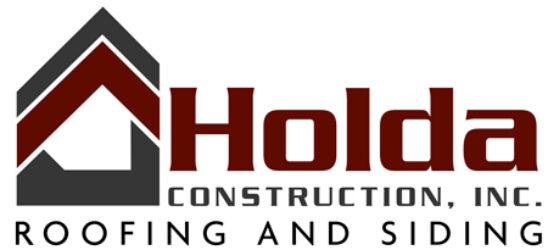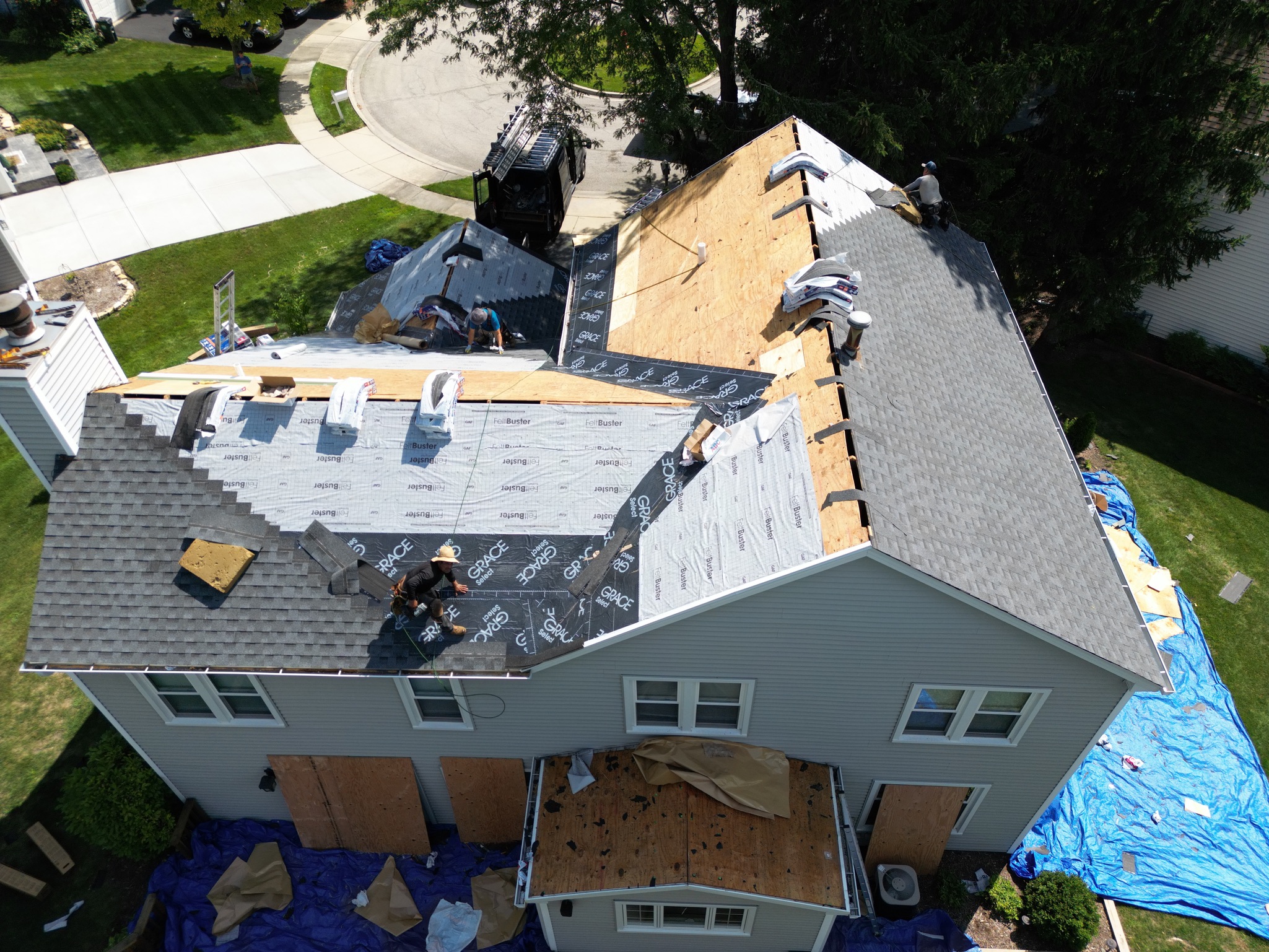Spring has sprung, bringing with it forecasts of severe wind and weather. When hail or windstorms strike, your roof can sustain significant damage, leading to leaks, structural weakness, and a decline in your home’s value. While dealing with these damages is stressful, homeowners can take some relief in knowing that many homeowner insurance policies cover hail damage to roofs.
However, navigating the claim process can be daunting. We, at Holda Construction, want to help in any way we can, so we created this article to provide a step-by-step guide for successfully filing an insurance claim for hail damage to your roof. But first, we want to help you better understand a typical homeowners insurance policy.
Understanding Your Policy: Actual Cash Value vs. Replacement Cash Value
Before diving into repairs, it’s crucial to understand two critical terms that impact your claim:
Actual Cash Value (ACV)
This is the amount you’ll initially receive from the insurance company, based on the current value of your roof after accounting for depreciation. The older your roof, the less money you’ll get upfront.
Replacement Cash Value (RCV)
This is the total cost to fully repair or replace the damaged roof with new materials. Homeowners must complete the work and invoice the insurance company to receive this value, which includes the ACV and the depreciation held back initially.
The Two-Part Payment Process: First Payment and Depreciation Payment
First Payment (ACV)
Once the adjuster has completed their assessment, you’ll receive your first payment, equivalent to the Actual Cash Value of the damaged roof. This amount should be enough to get the repair process started but won’t cover the total cost.
Complete the Repairs
It’s essential to get your repairs done by a reputable contractor. Keep detailed records and invoices as proof of repair costs.
Invoice the Insurance Company
After completing the repairs, submit the invoices to your insurance company. The difference between the ACV and the RCV (depreciation value) will now be paid to you.
Depreciation Payment
The insurance company will release the depreciation amount upon receiving and validating your invoices, thus giving you the Replacement Cash Value of your roof.
Let’s Compare Home & Auto Coverage:
Since auto and homeowner’s insurance have similar concepts and structures, many become confused by the differences between the two on how claims are filed.
With auto insurance, the Actual Cash Value (ACV) is generally used to determine the current market value of your car at the time of the accident, less any deductibles. If your vehicle is totaled, the insurance company will pay you this ACV amount. There’s usually no concept of Replacement Cash Value (RCV) in auto insurance, meaning you won’t be reimbursed for the cost of a brand new car, only for what your car was worth right before the accident. Many insurance customers could benefit from this because, if you find a similar car to your original, totaled vehicle for a price cheaper than the insurance-determined ACV, you can keep the cash difference between what your insurance company paid out as the value, and the purchase of your new (used) car.
In contrast, a homeowner’s insurance claim for a damaged roof often involves both ACV and RCV. Initially, you’re given the Actual Cash Value, which is the depreciated value of your damaged roof. This amount helps to kick-start the repair process. To give an example, if your roof was replaced ten years ago, and was expected to last thirty years, you will be given, initially, the depreciated value of your roof.
You can not, however, buy a used roof – and the insurance company understands you need to be made whole. To receive the full Replacement Cash Value, homeowners are required to complete the repair work and then invoice the insurance company. The insurance company will release an additional payment to make you whole, minus any deductible you have. This two-payment system, involving both an ACV payment and a depreciation payment, is unique to certain types of homeowner’s insurance claims and typically doesn’t apply in auto insurance.
Additional Tips:
Time is of the Essence
Ensure you complete all necessary work within the timelines specified in your insurance policy to qualify for the RCV.
Professional Help
Consider hiring a public adjuster if you believe the insurance company’s adjuster underestimates your damages. This is not always practical or appropriate, given that fees for a public adjuster can be 10% to 30% of the claim value, potentially leaving insufficient funds for quality repairs. While it is not always the case, public adjusters often collaborate with contractors who are primarily focused on insurance-driven work, potentially compromising service quality.
Read the Fine Print
Always read your policy carefully to understand any limitations, exclusions, or deductibles that may apply. This preemptive knowledge can prevent surprises about high deductibles or uncovered expenses. Ideally, homeowners should be well-informed about these details before any incident occurs, but may find themselves on a refresher course at this time.
Your Step-by-Step Process for Filing a Hail Damage Roof Claim:
To summarize, here’s a simple, easy-to-follow checklist of the steps that should be taken if you feel you’ve incurred hail damage:
1. Document the Damage:
As soon as you notice damage, take detailed photos and notes capturing the extent of the damage to your roof. This provides an initial record which can be invaluable during the claims process. If you do not have the time or ability to inspect for damage yourself, you can hire a local roofing contractor to inspect the roof and document the damage for you. Holda Construction is happy to help, requiring a deposit that can then go towards the cost of your new roof or roof repair.
2. Contact Your Insurance Provider:
Reach out to your insurance company to notify them of the hail damage, so they can initiate the claim process. This can typically be started on the company website, or can be done by phone.
3. Choose a Reputable Contractor:
While it’s a common practice to seek multiple estimates, and the key is not only to consider cost, but to select a local contractor with a strong reputation. A knowledgeable, experienced contractor will navigate the insurance process effectively, catching any oversights by the insurance adjuster early on.
Homeowners often seek multiple bids without realizing that the initial estimate given by each provider can change due to additional needs that pop up as the project unfolds: needs that can often be recognized earlier by experienced contractors. At Holda Construction, we use the same estimation software as insurance companies and document the details of each project meticulously through photos and videos, which not only justify the claims to the insurance company but also ensures our client benefit from our use of premium materials and the superior craftsmanship we provide. This distinguishes us from others who might only fulfill the basic requirements set by insurance in the aftermath of storm or hail damage.
4. Adjuster Evaluation:
Your insurance company will send an adjuster to assess the damage. Their report determines the Actual Cash Value (ACV) of your claim.
5. Review the ACV Payment:
After the adjuster’s assessment, the insurance company will offer an initial payment based on the ACV. This considers the roof’s age, wear, and current condition.
6. Begin Repairs:
Use the ACV payment to initiate the repair process. Engage your chosen contractor to start the necessary work.
7. Invoice & Claim the RCV:
Upon completing the repairs, submit the invoices to your insurance company. They will then release the depreciation amount, bridging the gap between the ACV and the Replacement Cash Value (RCV).
8. Review Final Payments:
Ensure you receive the full RCV for your roof. The total should comprise the initial ACV and the subsequent depreciation payment. If there are discrepancies, discuss them promptly with your insurance provider.
9. Retain All Documentation:
Always keep a record of all associated paperwork, which includes the repair invoices, the adjuster’s reports, and any communications with the insurance company. This will be useful for any potential future claims or references.
Understanding and following this step-by-step process ensures that homeowners can navigate the complexities of the roof claim process effectively, maximizing their claim’s potential and ensuring a swift restoration of their property.
In conclusion, understanding your insurance policy terms like Actual Cash Value and Replacement Cash Value, ensuring you’re working with a knowledgeable, reputable contractor, and knowing the steps involved in the claim process, will make it easier to navigate the challenging period following hail damage to your roof. Armed with this knowledge, you can restore your home while optimizing your financial recovery. Should you have any additional questions or feel like you need help with this, feel free to reach out to us at Holda Construction in Chicago’s Northwest Suburbs, 847.847.2883. We’d be happy to help clear any confusion!

